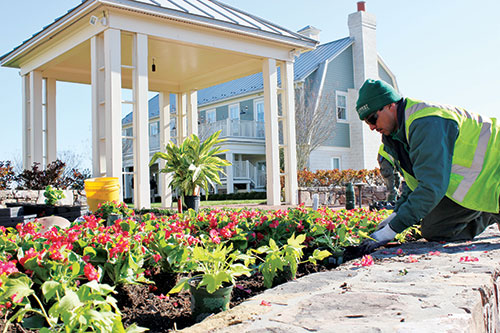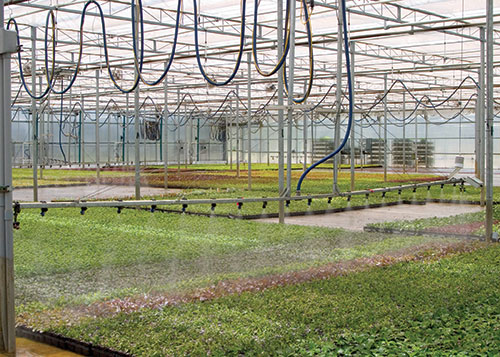
How landscape contractors can combat plant shortages.
After years of struggling during the economic downturn, the landscape industry has gradually made a comeback. But, not every aspect has returned to its prerecession level.
Plant shortages in the past few years have affected companies across the country. They’ve caused landscapers to spend more time finding, planning and purchasing plants.
Supply and demand
The industry first began to realize the plant shortages in 2009 to 2010, says Jeff Gibson, landscape business manager at Ball Horticultural Co. Suppliers changed some of their practices to survive the downturn, triggering the shortages.
Before the recession, growers and nursery suppliers would always grow a “buffer” to cover unanticipated orders from contractors, Gibson says.
“When the recession hit, they reduced the spec, guessing the contractors would likely not install and, therefore, buy as much color as they did previously,” he says. “The growers had to guess at how much they should reduce by. In 2010 and 2011, growers ran out of staples like begonias. That rarely happened before.”
During this time, several suppliers went out of business or cut back on the amount of plants they had in stock. Those that stayed opened held inventory for a year or two, but many discarded the plants after that time and did not replant because of the economic uncertainty.
“The whiplash effect is still with us today, as trees take four to five years to get to a reasonable selling size,” Gibson says. “Shrubs are quicker: two seasons often. That is all coming back now that building has returned, but there is still a lack of smaller caliper (plants), especially street trees.”
The tree shortage is something professionals are seeing across the country.
“Several growers had to burn old, big trees because no one was buying them,” says Gary Nienhuis, licensing manager at Spring Meadow Nursery in Grand Haven, Mich. “Now, we are trying to figure out how to get big material, and it’s just not there.”
A purchaser for Ruppert Landscape, Mary Angebranndt, has experienced trouble finding 3-inch caliper trees.
Ruppert is a full-service landscape firm with 18 branches in Maryland, Virginia, North Carolina and Georgia and $110 million in annual revenue.
Trees aren’t the only plant material facing a shortage.
“Here in the South, sod production is even down about 20 percent,” Angebranndt says.
With a limited supply, landscapers must spend more time tracking down plant material.
“Four years ago, a landscaper could call up one company and almost name his price, tell them what he needed and get it,” Nienhuis says. “Now, they are having to make multiple calls to get one product. For landscapers, trying to fulfill specific jobs or finding larger materials is a lot more work.”
Not only are the shortages demanding more time from contractors, they’re also making things more difficult on the job site.
“As a whole, it’s hurting us because we can’t meet clients’ and architects’ expectations because the material isn’t there,” Angebranndt says.
As the shortage continues, plant prices will rise, which poses concerns for contractors who need to set prices for future plant purchases.
“You have to almost look at your crystal ball and think what the price will be in two years,” Angebranndt says. “I think it’s scary for all of us. You don’t know what the economy is going to do.”
Natural causes

Other contributors to the shortages have been environmental factors like extreme weather and invasive pests, says Keith Kurian, owner of Green Inspirations Landscaping in Whitemouth, Manitoba. The full-service company has about $350,000 in annual revenue.
Kurian says he first noticed the shortages in June when he tried to order several junipers from a local nursery for an upcoming project. He ties the shortage to a cold but low-snow winter in his region.
“Without the snow cover, certain plants really suffered,” he says.
Kurian also has discovered trees are more stressed than normal, causing them to be more susceptible to diseases and insects—another factor that has played a role in the overall shortages.
Others agree: major pest-related concerns like Emerald Ash Borer on ash trees and impatiens downy mildew have compounded economy-driven plant shortages.
“Both hit at the peak of the recession and caused a major cutback in staple supply items for landscapes,” Gibson says. “Alternatives for impatiens and street trees have appeared, but it’s taken four to five years for the market to get used to them and start using them in bigger numbers.”
Be willing to change
To work around the shortages, Nienhuis says landscapers should be willing to try new and different plants and accept some substitutes when the product isn’t there.
Another way landscapers can ensure plant availability is to purchase early.
For example, Angebranndt says she’s had to take plant deliveries early, just so she wouldn’t lose them. Contractors should build solid relationships with their suppliers to determine a buying schedule will work best, sources say.
“A lot of nurseries want to turn the crop and not hold it for you,” Angebranndt says. “You need to find a balance. See if they will take a deposit and hold it for you.”
When specs call for larger plant material, contractors may need to buy even earlier.
“If you know you have a job that’s further out that’s going to require bigger crops, you need to get those materials locked down as early as possible,” Nienhuis says.
Landscapers also should design and bid with their growers’ availability listings in mind. “Gone are the days of allowing your clients to pick and choose from magazines to catalog the plants they want for their designs,” Gibson says. “Spending time trying to find obscure or unavailable items is inefficient and usually results in disappointed clients if the item is not found, or costs three times as much.”
Turnaround time
It will take time for the plant shortages to improve.
Angebranndt predicts the shortage will last another year or two. “Nurseries are gun shy about going overboard with plants,” she says.
Nienhuis foresees the industry making up ground by 2017. For larger trees, he says it may take until 2018 or 2019.
“There’s a lot dependent on the housing market and economy,” Nienhuis says. “It’s at least going to take the next couple of years to get all of the product they’re going to want.”
Photos: Ruppert Landscape, Spring Meadow Nursery
Dowdle is an Alabama-based freelance writer.

